

The Art of Making and Why Cardboard Modeling is Fantastic. - SolidSmack. It use to be that nothing made us happier than duct tape, a pile of cardboard scraps and a pair of sharp scissors.
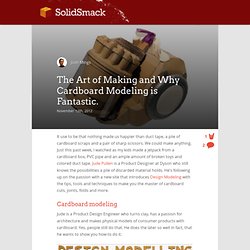
We could make anything. Just this past week, I watched as my kids made a jetpack from a cardboard box, PVC pipe and an ample amount of broken toys and colored duct tape. Jude Pullen is a Product Designer at Dyson who still knows the possibilities a pile of discarded material holds. He’s following up on the passion with a new site that introduces Design Modeling with the tips, tools and techniques to make you the master of cardboard cuts, joints, folds and more.
Cardboard modeling Jude is a Product Design Engineer who turns clay, has a passion for architecture and makes physical models of consumer products with cardboard. For Jude, cardboard modelling has been a means to and end, working with people from around the world, to create a physical model of an idea. Indeed we have. Physical or Digital? Lampes papier. Have you seen these amazing lamps?!
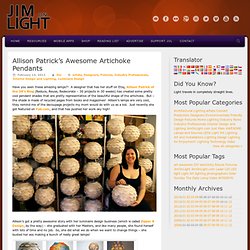
A designer that has her stuff on Etsy, Allison Patrick of the 3R’s Blog (Reduce, Reuse, Redecorate – 30 projects in 30 weeks) has created some pretty cool pendant shades that are pretty representative of the beautiful shape of the artichoke. But – the shade is made of recycled pages from books and magazines! Allison’s lamps are very cool, they remind me of the decoupage projects my mom would do with us as a kid. Just recently she got featured on Fab.com, and that has pushed her work sky high! Allison’s got a pretty awesome story with her luminaire design business (which is called Zipper 8 Design, by the way) – she graduated with her Masters, and like many people, she found herself with lots of time and no job.
Allison's stuff on Etsy Allison, JimOnLight.com thinks your works are awesome. Thanks Inhabitat for the original article! Like this: Like Loading... Related Allison Patrick, Designers, DIY, Fixtures, lamps, Luminaire Design, pendant, recycle, shades. New Cement/Paper Mache Clay Mixture. Today’s post is by Warren Eggleton, a reader from Australia.
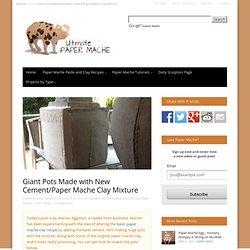
Warren has been experimenting with the idea of altering the basic paper mache clay recipe by adding Portland cement. He’s making huge pots with the mixture, along with some of the original paper mache clay, and it looks really promising. You can see how he makes the pots below. Warren says: Jonni, I have had some success with the cement paper clay mix which is: This mixture is quite similar in consistency to your clay mix, not quite as good but ok. I mixed an 8 roll batch of this mix, the temp was 32c =89f, it took me 1.5 hours to get this applied to the pot armature and I just finished as it was starting to stiffen. I did one since then where the temp was down to 23c=73f and I had some left over and it was still workable after 2 hours.
Paper Mache Recipes. This page contains recipes for several kinds of home-made paper mache paste, and home-made gesso recipes for finishing your sculptures.
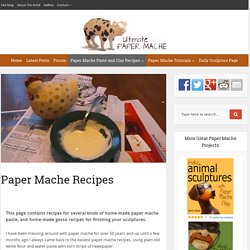
I have been messing around with paper mache for over 50 years and up until a few months ago I always came back to the easiest paper mache recipes, using plain old white flour and water paste with torn strips of newspaper. Now, however, I have abandoned the traditional layered paper process and use my new paper mache clay recipe and/or the even newer silky-smooth air-dry clay recipe for most my sculptures. Gourmet Paper Mache. How To Make Pulp Ala Miranda Rook. You will need: - Glossy magazines- Egg cartons- Colander- Drainage bag- Papier mache paste of choice- Electrical tools (adults only!)
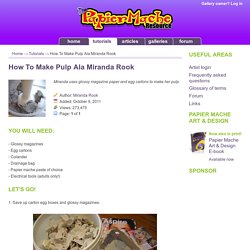
Let's go! 1. Save up carton egg boxes and glossy magazines. Paper Mache: Recipes & Tips. You can make all kinds of crafty items with paper mache (not just the school volcano project): Decorative masks, bowls, ornaments, Halloween & Christmas decorations, you name it–you can likely make it.
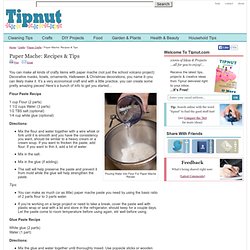
It’s a very economical craft and with a little practice, you can create some pretty amazing pieces! Here’s a bunch of info to get you started… Pouring Water Into Flour For Paper Mache Recipe Flour Paste Recipe 1 cup Flour (2 parts) 1 1/2 cups Water (3 parts) 1/2 TBS salt (optional) 1/4 cup white glue (optional) Directions: Mix the flour and water together with a wire whisk or fork until it is smooth and you have the consistency you want, should be similar to a heavy cream or a cream soup.
Tips: Paper Mache Clay. Several years ago I developed a new recipe for a sculptural material I call “paper mache clay.”

This material is so easy to use and so easy to make that I now use it exclusively for all my paper mache sculptures. The recipe has now gone “viral” and is being used by artists all over the world. It might be a bit more accurate to call this material “home-made air-dried cellulose-reinforced polymer clay,” but that’s way too hard to say (or type!)